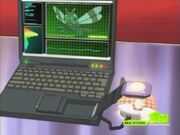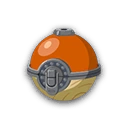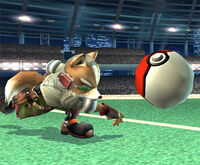- For information on the regular type, see Poké Ball (item).
- For information on the Poké Ball used in the Hisui region, see Poké Ball (Hisui).

A variety of Poké Balls, as depicted in Pokémon Dream World
Poké Balls are spherical devices used by Pokémon Trainers to catch wild Pokémon or store their own Pokémon. There are many types of Poké Balls, the most common and basic of which is the namesake red and white type.
Poké Balls are arguably the most distinctive symbol of the Pokémon franchise. In the Pokémon World, it is common to find references to Poké Balls, such as battle arenas bearing the circular shape of a Poké Ball or them being a decorative element on walls and floors. Even some Pokémon bear the shape or design of a Poké Ball, such as Voltorb, Foongus and their respective evolutions.
Description[]
Appearance[]

Artwork of the titular red and white type for Pokémon FireRed Version and Pokémon LeafGreen Version
All Poké Balls are spherical objects separated into two halves, each being a different color, with the bottom one usually being white. These two halves are separated by a center line, which is usually black, and in the middle is a round button. Although the purpose of the button is not shown in the core series, it is shown in Pokémon the Series that it activates the Poké Ball, causing it to increase slightly in size, and the Poké Ball flashes red if no Pokémon is occupying it. The inside of a Poké Ball features many of what appear to be mirror panels, which are supposedly designed to keep the Pokémon feel comfortable while they are inside of the Poké Ball. Pokémon are conscious even while inside of a Poké Ball and able to hear sounds from outside.
Poké Balls are small so that they can be carried by children and adults alike, facilitating their second function: the transport of Pokémon. In the games, Poké Balls always have a fixed size, while in the anime, they expand slightly when they are used. Despite their small size, Poké Balls can store large species of Pokémon inside, such as Snorlax or Wailord.
In the anime, Poké Balls are shown to not be very resistant. For example, in "DP073: Crossing Paths," Jessie was able to break a Poké Ball by stepping on it. From this, Poké Balls are shown to have electronic components, such as cables. Although, as Cesar does, it is possible that the Poké Balls have some kind of material produced from Apricorns.
Function[]

A Druddigon being captured in the anime: The open Poké Ball is in the air, and the red beam of light with the Pokémon's silhouette is shown heading towards the inside of the Poké Ball.
Poké Balls were designed to be lightweight, practical, and effective. They can store Pokémon in a very small space, regardless of weight or size, by converting its matter into energy. Upon contact, a Poké Ball flips open, draws a Pokémon inside by converting it into energy, and then closes.
Wild Pokémon are able to resist and break free from a Poké Ball used on them. However, it is harder for weakened Pokémon and those affected by a status condition to break out, making them easier to catch. In the core series of games, if a Pokémon frees itself, the Poké Ball breaks irreparably, but in the anime, the Poké Ball rebounds to its trainer. In the core series of games, certain Pokémon have to be caught into a Poké Ball as quickly as possible before they escape: This is done mostly by Legendary Pokémon, including Latios, Latias, Suicune, Raikou, Entei, Mesprit, and Cresselia, but a few regular species can do this if they use Teleport, including Abra and Ralts. Wild Pokémon are more prone to being caught by either using Hypnosis to put them to sleep temporarily or Mean Look to make them unable to flee in battle.
If a Poké Ball does catch a wild Pokémon, the battle concludes successfully. A caught Pokémon stays in its Poké Ball until its trainer willingly calls it out, especially during a Pokémon Battle. A few Pokémon dislike being inside of a Poké Ball, most notably Ash's Pikachu. In the early anime series, whenever a Pokémon is sent out of its Poké Ball, the background dims while a white light emerges from the Poké Ball before forming into the Pokémon. A Pokémon can only be returned into the Poké Ball from which it was caught. In the games, while a Pokémon Trainer has a full party of six Pokémon, any other Pokémon caught are transferred to the trainer's Pokémon Storage System automatically, including their Poké Ball.
Capturing[]

Ash catching a Riolu in the anime episode "PJ021: Caring for a Mystery!"
To capture a Pokémon, the trainer must throw a Poké Ball at it directly. When the Poké Ball hits the target Pokémon, it bounces off of it. In the games, what follows is the Poké Ball opening, creating a brief flash and instantly drawing the Pokémon inside. In the anime, a red beam of light envelops the Pokémon, seemingly transforming it into pure energy, and forcefully transports it into the Poké Ball. The ball then falls to the ground, and begins to swing as the center button flashes red. In all forms of Pokémon media, if the Pokémon is successful at resisting, the Poké Ball will open, releasing the Pokémon, whilst if the capture is successful, the Poké Ball stops moving (and flashing red in the anime), and the Pokémon stays inside.
Following a successful capture, the trainer becomes the owner of the Pokémon. In Pokémon Black Version and Pokémon White Version, when Team Plasma leaves Opelucid City, Drayden explains that even though Pokémon are trapped in Poké Balls, it does not mean they begin to like the trainer. Each Poké Ball can only carry one Pokémon at a time.
An unsuccessful capture is usually because a Pokémon is being held against their will and has the strength to break free. However, Dark Balls and Snag Balls (converted from ordinary Poké Balls) can capture a Pokémon against its will. The most effective type of Poké Ball is a Master Ball, which never fails at capturing a Pokémon, regardless of its will, and because of this, Master Balls are commonly used to catch Legendary Pokémon. In the core series of games, if a Pokémon Trainer ever misuses a Poké Ball to try and capture another trainer's Pokémon, that trainer blocks the Poké Ball to prevent their Pokémon from being stolen.
In the anime, Poké Balls are shown to be designed to fail when used on a Pokémon that has already been caught by a Trainer to prevent theft.
Storage[]

A Yanma being examined by a laptop in the anime episode "DP080: The Thief That Keeps On Thieving!"
While a Pokémon is inside of its Poké Ball, it rests, but this does not recover its HP or any status condition. A Pokémon has an exclusive connection to its Poké Ball, so it cannot store a different Pokémon than the one it had caught. In such cases, the Poké Ball bounces off the Pokémon and returns to the trainer's hands, which prevents Pokémon from being stolen. Likewise, a Pokémon always returns to and lives in the same Poké Ball.
Various machines can interact with Pokémon inside of Poké Balls. In Pokémon Centers, the trainer can hand over their Poké Balls to the Pokémon Center Lady, who then inserts the Poké Balls into a machine for a few seconds, fully restoring the Pokémon's health and curing them of any status condition. Additionally, in the anime, it is shown that Pokémon within Poké Balls can have their characteristics examined with a Pokédex, which is commonly used by Paul to determine whether he wants to keep a Pokémon or not.
If a Poké Ball is either damaged or broken, the Pokémon inside is released, but it remains loyal to its trainer. For example, in one episode of the anime, Ash drops his Snorlax's Poké Ball on a rock, causing Snorlax to pop out, but it does not leave. On the other hand, a Pokémon Trainer can willfully release a Pokémon back into the wild. In the games, the player can release one of their Pokémon by pressing a certain option on the PC to eject the Pokémon and release it into the wild. In the anime, a trainer can just remove a Pokémon from its Poké Ball, which emits a blue ray of light instead of red to indicate that the Pokémon has been released. In the case of Paul's Chimchar, it switched trainers from Paul to Ash.
A Pokémon Trainer can have only six Pokémon on them at a time, a rule enforced by the Pokémon Association in the manga; although this means only six Poké Balls containing a Pokémon can be carried at once, a trainer is allowed to carry as many empty Poké Balls as their Bag can support. A trainer usually carries their Poké Balls in a pocket or belt, allowing them to quickly access the Poké Balls if they need the assistance of one of their Pokémon, especially in urgent situations. Though the Pokémon Storage System is where additional caught Pokémon are sent in the core series of games, some of the Pokémon that Ash caught in the anime would be sent automatically to Professor Oak's Laboratory whenever his party is full.
Appearances[]
Games[]
Core series[]
Over thirty types of Poké Balls have appeared throughout the span of the core series, and more varieties are introduced in every generation except Generation VI. Most varieties of Poké Balls are more specialized in their purpose, making it easier to capture certain Pokémon or within certain environments.
Certain areas allow the player to take and use only certain types of Poké Balls, including the Safari Zone of Kanto, the National Park and Safari Zone of Johto, the Safari Zone of Hoenn, the Great Marsh and Pal Park of Sinnoh, and Entree Forest of Unova.
The presentation of using Poké Balls in a Pokémon Battle changes between some of the generations. In the first two generations, a Poké Ball divides into half when either releasing or capturing a Pokémon before closing again. Since Generation III, Poké Balls open only partially when capturing or releasing Pokémon, and each Poké Ball is given a unique animation in battle. From Pokémon Diamond Version and Pokémon Pearl Version onward, Poké Balls can also be decorated with stickers, which display different effects when thrown into battle.
Generation I[]
Generation I introduces five types of Poké Balls. The regular type has the lowest catch rate, which is determined by the likelihood of catching a wild Pokémon, but this is mostly influenced by how low its HP is. The other four Poké Ball varieties have each have higher catch rate than the regular Poké Ball. Safari Balls are the only Poké Balls to have an added distinction besides a higher catch rate in that they are usable in the Safari Zone only. Regular Poké Balls, Great Balls, and Ultra Balls are all purchasable at Poké Marts, with the regular type being both the cheapest and earliest type that the player can afford. Master Balls are very rare and obtainable only under a few circumstances, just like in later appearances.
| Image | Name | Description |
|---|---|---|
 |
Poké Ball | The most basic type of Poké Ball, also having the most default catch rate |
 |
Great Ball | Has a fifty percent higher catch rate than a regular Poké Ball |
 |
Ultra Ball | Twice as likely to catch a wild Pokémon than a regular Poké Ball |
 |
Safari Ball | These have the same catch rate as Ultra Balls except they are usable only in the Safari Zone. |
 |
Master Ball | Very rare Poké Balls that never fail at catching a wild Pokémon |
Generation II[]
Besides the five returning Poké Ball types, Generation II introduces more Poké Ball variations were introduced. Seven of the types of Poké Balls are created by Kurt using Apricorns, each of a different color. Sport Balls are the only introduced Poké Ball type that is not created by him. Instead of increasing their catch rate in general, most of the introduced Poké Ball types have a higher catch rate on only certain types of Pokémon.
| Image | Name | Created from | Description |
|---|---|---|---|
 |
Fast Ball | White Apricorn | More effective on faster Pokémon and those that can flee from battle |
 |
Friend Ball | Green Apricorn | Increases the friendship of the caught Pokémon |
 |
Heavy Ball | Black Apricorn | Specializes in the capture of heavier Pokémon |
 |
Level Ball | Red Apricorn | More effective the lower a wild Pokémon's level is than the player's Pokémon in battle |
 |
Love Ball | Pink Apricorn | More effective on a wild Pokémon of the opposite gender than the player's Pokémon in battle |
 |
Lure Ball | Blue Apricorn | Has a very high catch rate on Pokémon encountered while fishing |
 |
Moon Ball | Yellow Apricorn | The most effective on Pokémon that evolve via a Moon Stone |
| Sport Ball | N/A | Usable only in the Bug-Catching Contest |
A ninth type of Poké Ball, the GS Ball, appears in the Japanese version of Pokémon Crystal Version as a key item. The GS Ball only summons Celebi in Ilex Forest, and it cannot be used like other Poké Balls in battle.
Generation III[]
Seven varieties of Poké Balls were introduced in Generation III. None of the Poké Balls introduced in Generation II make a reappearance, nor are any Poké Balls created from Apricorns.
The introduced Poké Ball varieties and their functions include:
| Image | Name | Description |
|---|---|---|
 |
Dive Ball | Has an increased chance of catching Pokémon underwater |
 |
Luxury Ball | A Pokémon caught within it has a faster increase in its friendship level with the trainer |
 |
Nest Ball | Functionally similar to the Level Ball by specializing in capturing lower level Pokémon |
 |
Net Ball | Highly effective on Bug-type or Water-type Pokémon |
 |
Premier Ball | Has the exact same effect as the regular type but has a different design |
 |
Repeat Ball | Has a high catch rate on Pokémon that the player has caught before |
 |
Timer Ball | The catch rate increases as more turns pass during a Pokémon battle |
Generation IV[]
All Poké Ball types from the previous three generations return in Generation IV, which also adds five more types. Though the Poké Balls from Generation II are not made of Apricorns in the Sinnoh games (Pokémon Diamond Version, Pokémon Pearl Version, and Pokémon Platinum Version), they are in the remakes of the Generation II games, Pokémon HeartGold Version and Pokémon SoulSilver Version. Dive Balls are more effective on Pokémon in aquatic areas in general, namely surfing or fishing, being similar to the Lure Ball in the latter case.
| Image | Name | Description |
|---|---|---|
 |
Cherish Ball | Not a usable item but various event Pokémon are contained within one |
 |
Dusk Ball | Has a higher catch rate in dark areas, including caves or at night in general |
 |
Heal Ball | If the Pokémon is caught, all of their HP and PP is fully restored |
| Park Ball | Usable only in the Pal Park, where they always succeed in catching Pokémon, like with Master Balls | |
 |
Quick Ball | Has a very high catch rate on the first turn only |
Generation V[]
Since Generation V, the introduction of more Poké Ball variants has been a lot less common. Dream Balls are the only Poké Ball variety introduced in Generation V.
| Image | Name | Description |
|---|---|---|
| Dream Ball | Has a high catch rate on sleeping Pokémon |
Generation VII[]
Though no Poké Balls were introduced during the previous generation, Generation VII introduces only one type, Beast Ball, similarly to Generation V.
| Image | Name | Description |
|---|---|---|
 |
Beast Ball | Has a higher catch rate when used on an Ultra Beast specifically. |
Generation VIII[]

A Hisuian Poké Ball in Pokémon Legends: Arceus
Several varieties were introduced exclusively in Pokémon Legends: Arceus. Three of these varieties are the Hisuian counterparts of Poké Balls, Great Balls, and Ultra Balls. A Heavy Ball was added, but it has no relation to those from the Generation II games. The Heavy Ball has two upgraded varieties, Leaden Balls and Gigaton Balls. Feather Balls were also introduced, along with two upgraded varieties, Wing Balls and Jet Balls, though all three specialize in the capture of -type Pokémon. Lastly, there is the Origin Ball, which is used specifically to capture Origin Forme Dialga or Palkia.
The Strange Ball is not a usable Poké Ball; instead, it represents any unidentiable Pokémon transferred into games from Pokémon Brilliant Diamond and Pokémon Shining Pearl onward.
Spinoffs[]
Pokémon Stadium series[]
Poké Balls represent the difficulty levels in the Stadium mode of Pokémon Stadium and Pokémon Stadium 2. From lowest to highest, the four difficulty levels are named Poké Ball, Great Ball, Ultra Ball, and Master Ball; the name of each higher difficulty level corresponds to the increased catch rate of its namesake Poké Ball in the core series.
Exclusively in the story modes of Pokémon Colosseum and Pokémon XD: Gale of Darkness are Snag Balls, which are modified Poké Balls that were designed by Cipher to steal Pokémon from other trainers within their agenda to convert Pokémon into shadow Pokémon. Conversely, Wes and Michael of the respective games use Snag Balls to steal back the shadow Pokémon and purify them into their original forms.
Pokémon Snap[]
In Pokémon Snap, there are Pester Balls, which Todd can use only to stun Pokémon, not to capture them. Pester Balls are the first type of Poké Ball that cannot catch Pokémon.
Learn with Pokémon: Typing Adventure[]
In Learn with Pokémon: Typing Adventure, there are Typing Balls, which are capable of catching Pokémon like any other Poké Ball, but they were created to go along with the game's theme of teaching users to type.
Crossover[]
Super Smash Bros. series[]
| More information about Poké Ball can be read on Smashpedia. |

Fox throwing a Poké Ball in Super Smash Bros. Brawl
Regular Poké Balls appear as items in every game of the Super Smash Bros. series, beginning with the first game. Poké Balls can be picked up by fighters and thrown to the ground for a random Pokémon to come out. Most Pokémon attack the opponents on behalf of the user, and all summoned Pokémon disappear after a while. In Super Smash Bros. for Nintendo 3DS, Master Balls were added as items, and they always summon a Legendary Pokémon, which occurs seldomly from regular Poké Balls. Neither type of Poké Ball can capture the playable Pokémon fighters, such as Pikachu, but they do appear from regular Poké Balls as part of their stage entrance animation.
Anime[]
In Pokémon the Series, nearly all trainers use regular Poké Balls, but some varieties from the games have also appeared. The GS Ball is the second type of Poké Ball to appear in the anime. Some of the regular Poké Balls depict symbols to denote a specific purpose, such as a fish symbol if they are used for fishing.
Manga[]
In Pokémon Adventures, Poké Balls are commonly used. The biggest difference having their upper half, allowing one to see the Pokémon contained within.
Trivia[]
- Even though Poké Balls are able to contain strong Pokémon, they are still capable of breaking in different ways. This can be seen by methods such as brute force as seen with Eternatus in the anime, which was able to release itself from a Poké Ball by splitting it in half, and with Gary and Ash breaking one, or by a variety of attacks such as the corrosive nature of Poison attacks.

